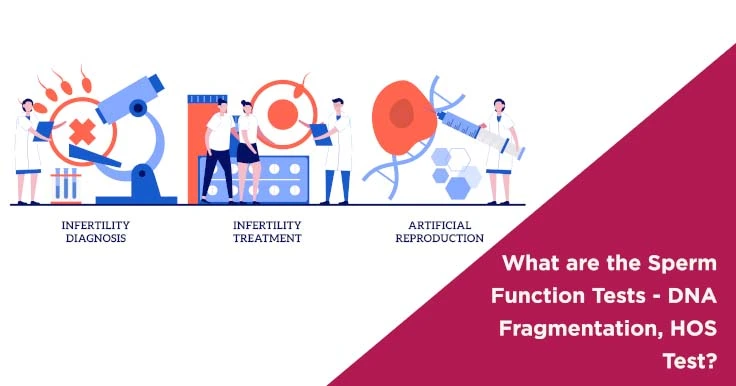Sperm Function Tests: Understanding DNA Fragmentation and HOS Test

Infertility is not something that only affects women. In many cases, issues with sperm are the reasons for a couple's inability to conceive. If a man has been diagnosed with a low sperm count, further tests may be advised to identify the cause for the low sperm count and to check for what type of fertility treatment will be best suited to the couple. These specialized sperm function tests help determine factors such as how well the sperm survives after it has been ejaculated, how they will behave in an IVF cycle etc.
Common Sperm Function Tests
Two of the most common types of sperm function tests are:
Hypo-Osmotic Swelling Test
A HOS test is used to measure sperm vitality on the principle that live sperms will swell up when they absorb a hypo-osmotic solution. This test is indicated when a large number of immotile sperms are seen on a routine semen analysis, as it helps to differentiate dead sperms from sperms that may be alive but are immotile. The semen sample and HOS medium are warmed to 37 degrees and then mixed together. The solution is then kept in an incubator for half an hour. It is then again examined under a microscope. The living sperm will appear to have bloated or curved tails while the dead sperms will appear the same as before.
The percentage of live sperms is calculated on the basis of the status of 200 sperm cells.
Sperm DNA Fragmentation
Sperm contains DNA that can be easily damaged by exposure to toxins and oxidative stress. Certain types of therapies such as chemotherapy may also affect sperm DNA. The DNA fragmentation test helps evaluate the percentage of damaged sperms against the healthy sperms and the extent of damage done.
Sperm with damaged DNA can fertilize an egg. In cases of slight damage, the egg can repair the damaged DNA but in cases of severe damage such as double-strand breaks, there is little that can be done. This type of damage may lead to a miscarriage or cause genetic problems in the foetus. Hence the sperm with severely damaged DNA must be separated from the other sperm before they can fertilize an egg.
How to Analyse DNA Damage in Sperm
There are many different ways to analyze DNA damage in sperm. A terminal deoxynucleotidyl transferase medicated 2-deoxyuridine 5-triphosphate (TUNEL) and single cell electrophoresis (COMET) are the most direct methods. Indirect methods such as sperm chromatin structure assay (SCSA) may also be used to analyze the integrity of sperm chromatin. Similarly, DNA intercalating dyes may be used to differentiate between single and double-stranded DNA.
These tests help couples decide what form of fertility treatment is best suited to them and if they need to make any lifestyle changes to boost fertility.
Other Advanced Tests
In addition to these tests, a number of other advanced tests may also be carried out such as:
- Electron Microscopy - This is a test that can help identify any defects in the nucleus, acrosome, centrosome or tail of the sperm. For example, it may be used to identify defects related to Kartagener's syndrome that can affect the sperm's motility.
- Presence of Anti-Sperm Antibodies - Sometimes, a man may develop anti-sperm antibodies. They can affect the viability and motility of sperm. Hence, a test may be conducted to check for the presence of these antibodies.
- Sperm Molecules - This is still mostly in its experimental stage. This test detects the presence of certain molecules that are needed to stimulate the fertilization of the egg.
 Infertility Counselling
Infertility Counselling Female Infertility Treatment
Female Infertility Treatment Andrology Treatment
Andrology Treatment Fertility Enhancing Surgeries - Female
Fertility Enhancing Surgeries - Female Fertility Enhancing Surgeries - Male
Fertility Enhancing Surgeries - Male Endoscopy Treatment
Endoscopy Treatment IUI Treatment
IUI Treatment IVF Treatment
IVF Treatment ICSI Treatment
ICSI Treatment Advanced IVF Solutions
Advanced IVF Solutions Embryology
Embryology Vitrification Egg, Embryo, Sperm Freezing
Vitrification Egg, Embryo, Sperm Freezing Preimplantation Genetic Testing (PGT)
Preimplantation Genetic Testing (PGT) Donation Program Embryo / Egg / Sperm
Donation Program Embryo / Egg / Sperm Self-cycleTM IVF
Self-cycleTM IVF

 Self-cycleTM IVF
Self-cycleTM IVF









